The Stuck Drill Story
January 24, 2009
RECOVERY LAKES, ANTARCTICA– Leaving site 5!
Today we are finally on the move again, after a prolonged stay at our science stop at site 5 in the middle of the Recovery Lakes area. We were delayed after our ice core drill was stuck 90m down in the hole Lou was drilling.
Drills do get stuck– every once and a while the chips, or the small pieces of ice that are generated as the drill spins around, get packed and the drill can become wedged in the ice. Sometimes the anti-torques, the metal fins that keep the drill from spinning in the hole as the inner barrel turns, get stuck. It happens. By pouring alcohol or glycol in the hole, drillers can sometimes turn enough of the ice around the drill into slush to pull the drill out again.
Drills have been successfully recovered that way. In our case, however, the cable had snapped, at the top of the pulley that lowers the drill into the hole, while the drill was at the bottom—exactly 92m below the surface. With the cable snapped and the drill that far down, we were in a bad position. Drills stuck closer to the surface have to be dug out by sheer manual labor, but 92m is too deep to dig, even for our team.
I was out at the drill site when it happened, picking up a couple of things for my own shallow, hand coring operation. I heard an ominous snap, and turned around to see the snarled end of the cable up near the pulley, with no drill in site, and the rest of the cable gone. “Oh @#!&!” was the only cohesive thought I had.
Sometimes when things like this happen (and they happen all the time out here), you think to yourself, “Oh, we can fix that, it will be ok.” But in this case, I knew right away that this was really, really bad, and that we probably wouldn’t be able to fix it. No drill meant that we would be essentially done with most of the science part of the trip, with the exception of the radar surveys that were being done as we drove. Lou was understandably upset, and we all started right away figuring out what we could do.
Lou knew that there was another similar drill that had been at South Pole being used in a separate project. We had no flights from the US Antarctic Program budgeted for our project after leaving South Pole, but this was an exceptional situation. Lou and Tom started working on figuring out where the second drill was (unfortunately already back in McMurdo, and not in the best of shape!) and if we might possibly get a flight, while Svein, our super mechanic, started on his own project, building a hook that might be able to catch the cable.
Our secret weapon in our quest to extract to the drill was the Borehole Optical Stratigraphy System (BOSS) that we had brought along. The BOSS is a borehole camera that I had been using to log the holes we had been drilling along the traverse. It was designed by Dr. Bob Hawley, currently a professor at Dartmouth College, who uses the reflectance from the borehole wall recorded by the images in the camera to map the varying layers in the hole. The variations in reflectance down the hole are due to variation in grain size and density of the different layers in the snow and ice. It’s a really neat piece of science equipment that was about to come in very handy as we tried to retrieve the drill.
We sent Bob’s camera down the hole to see where the end of the cable was, and what it looked like. 60m down in the hole, we found the end of the cable, a twisted mess of the metal strands, and could see a few meters down further that it continued to twist on it’s way down. The force of the break had twisted the cable, and it lay snarled in the last 30 m of hole down to the drill.
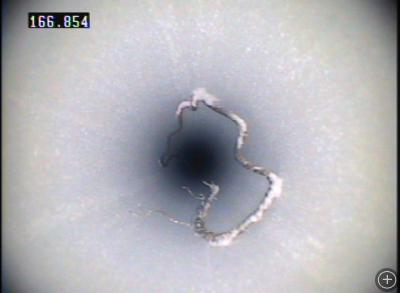
The image from the borehole camera, showing the broken end of the cable stuck in the hole 60 meters below the surface.
Not pretty, but perfect for the hook that Svein was working on, as the tangled cable provided places to hook onto. Svien’s hook consisted of four barbs, each with a sharp edge on the inside of the hook. Have I mentioned Svein is an avid fisherman back in Norway? Knowing now the exact depth of the cable end, and how it was lying in the hole, we went about fishing. At this point, no one, except for maybe Svein, thought that this was going to really work, but we were basically stuck out in the middle of nowhere, with months already invested in this part of the project, years invested in the traverse, with nothing else to do without the drill. So fishing we went, including a ceremonial spit on the hook which is apparently what you do for good luck in Norway. Lou lowered the hook down into the hole most of the way with the mechanical winch, and Svein and Ole lowered the last meter to the end of the cable by hand, with Svein, gloveless in the -26 deg C weather, seeing if he could feel the extra weight of the hooked cable. This was a bit tricky as 60 m of cable, plus the hook, is heavy enough as it is.
Lou started to pull up the winch, not sure if we had anything. There is a load cell on the top of the pulley for the cable which tells her if she has ice in the barrel or not, and we all watched to see if the load on the hook was increasing. A few meters from our fishing attempt, the load started to increase steadily– amazingly. It kept increasing as Lou slowly pulled the hook up with the winch, and we all watched, hardly being able to contain our excitement. Was this really working after all? Then, 11 meters from the surface, the load on the pulley suddenly decreased — we had lost the cable.
So, we went down the hole with the camera again. This time the cable was 5m lower than it had been. Svein went fishing again, and again the load started increasing as we pulled up the tangled cable wound at the bottom of the hole. A couple of times, the pulley snapped up and down and the load increased a great deal, only to release. We were pulling up and straightening bits of cable that had been tangled and stuck into the walls of the borehole. The snaps brought gasps from the field team gathered anxiously around Lou– all of us afraid that the cable would snap, and we would loose our drill for good.
Lou managed to pull the cable up to 7m from the surface next time before we lost it once again. Down went the camera once more, to find the end of the cable closer to the surface, meaning we had untangled more cable. Again Svein did the fishing, and Lou pulled the cable up 6m from the surface before we again lost the cable. Once more we lowered the camera, and saw that the end of the cable was now even more snarled and twisted from all the pulling– a perfect knot had formed that Svein might be able to catch, and Lou might be able to pull all the way to the surface. This was going to be the best shot we had at getting the cable back up to the surface, then hopefully being able to pull the drill up with it.
We had perfected finding the cable with the BOSS, fishing for the end, grabbing it, and getting it agonizingly close to the surface. Svein had been wanting to send the camera down with the hook so that he could see what he was doing, and I had been reluctant to do so with Bob’s camera. As a general rule, it’s not a good idea to send two things down a borehole—it you have two separate cables, as we did with the camera and drill, they can wrap around each other, and you can end up with one or both things down the hole. None of us wanted to lost both the drill and Bob’s camera. We called Bob on the Iridium phone, and he very willingly told us to go ahead and give it a try, even risking his camera (which we offered to replace if we did).
Lou lowered the hook again, and then I lowered the camera. Five different people were shouting directions to me as I maneuvered the camera into place– watching carefully on the way down to make sure that the camera cable was not twisting around the winch cable– while everyone huddled around the small LCD screen that the camera projected on to. I got to the hook, and was reluctant to get too close to it for fear of getting stuck in the mess of the cable and the hook. But I was able to get the camera down to where we had a good view of the cable, and Svein watched on the screen as he told Lou where to lower the hook.
We watched the camera as Lou was able to grab onto the mess of the cable end. I pulled the camera up 8 m, and waited for Lou to pull the hook up to see if we had the cable, and if it was slipping. When Lou got the hook up to the camera, the cable was still there, stuck even more onto the hook from the weight below. I pulled the camera out of the hole, relieved to have that done with, and the camera safe and sound back in its box. Lou pulled up the cable, and again we watched the load on the pulley increase as she pulled it closer and closer to the surface. We lowered the camera down into the hole two more times to make sure we had the cable (each time as stressful as the first for me for fear of losing Bob’s camera) then we got 7m, then 6m, then 5m, 4m and 3m from the surface, with more load on the pulley than we had seen before.
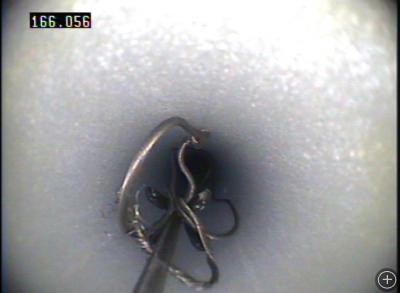
Another picture from the borehole camera, showing the hook that our mechanic Svein made snagging the broken end of the cable.
Here Lou stopped– we had come so close to getting it up before only to lose the cable in the end, and 3 m wasn’t all that far to dig. So we dug. The entire field team pitched in to dig a huge 3m deep trench while Lou kept the hole covered so that we wouldn’t knock snow down over the hook. When she cut away the last block covering the hole, there was the hook, with the cable attached. Svein and Andreas secured the bottom cable with clamps to prevent losing it again, and Lou pulled it the rest of the way up.
We all gathered around the hook with the broken end attached, amazed that it had worked, and happy.
This was just the beginning however.
Now we had to get the drill, still stuck 92m below the surface, up and out of the hole. And it was really stuck. Lou had already had some problems freeing the bottom of the cores she had drilled (the core break) so that she could pull them up. The ice was brittle and strange here, much harder than anything Lou had experienced before. The drill had also spent a couple of days down at the bottom of the hole by the time we got the cable up to the surface, allowing the chips to sinter (solidify) and the drill to get stuck fast.
Lou went about pulling the drill up with the winch. She had to apply a lot of force to the cable, and we all stood well back in case the cable should snap again. A few jerks managed some terrific pops as more of the tangled cable was pulled free from the bottom of the hole. At one point, Lou thought one of the tangles coming loose was the drill, and we all cheered triumphantly. We realized it wasn’t the drill after the load on the pulley decreased again however. The drill was stuck, extremely, extremely stuck.
We didn’t have any ethanol with us, but Lou really felt like if we had some, we could get the drill out. Meanwhile, the second drill was being put back into working order and shipped back to South Pole, in the case that we would get an unplanned flight after all. Flight requests were made, and after a couple of days of waiting anxiously, we heard that we would get the flight, with the ethanol and the second drill in case we didn’t get the stuck drill out.
Weather delayed the first scheduled flight, and we had to wait another day before we finally got the ethanol and could try again. The flight came just before midnight our time, and Lou, Svein, Andreas, Stein and Tom got to work on pouring the ethanol down the cable into the hole. Svein made a special “ethanol delivery system” consisting of a bottle, rope, and small covered hole that he could open right over the drill so that the ethanol was getting right to the drill and not sloshing all over the hole. The group worked through the early hours of the morning, pouring ethanol into the hole, waiting, and pulling on the cable, until 7 hours later, just after 7am, the drill started coming up, slushy and half frozen still, but up and out of the hole. To our amazement.
This is the traverse that will not quit. Already, we are attempting one of the longest science traverses ever made in Antarctica, through some of the coldest, highest, most remote locations. Vehicle problems? No problem. Radar problems? No problem. And then this, the problem of all problems with the drill stuck 90m down and no cable to pull it up, seemingly impossible to solve, threatening to end our science. But together, even when not sure we will succeed, we set out, step by step, meter by meter, kilometer by kilometer, undaunted, until we get across this continent. Our motto: science happens, all the time.


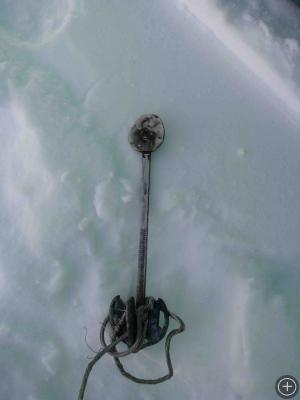
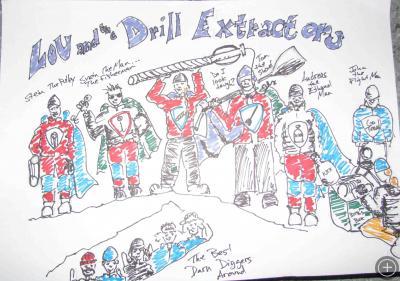



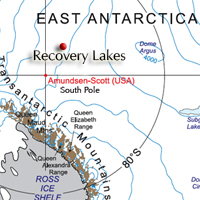





Incredible.
You guys put MacGyver to shame.
BRAVO! Epic problems; great story Zoe!!
You’ve qualified to enter endoscopic surgery schoo!! what a story! Here’s to safe travels stateside.
Well done Zoe! As an exploration geologist used to getting gear stuck, and sometimes lost, I can emphasize. BUT, I’m used to it in nice, warm, arid terranes where additional cost is the issue (and logistics usually aren’t too big a deal) – not loosing the whole field season – and near Recovery Lakes!!
I’m going to send your story to some of my driller mates, who I’m sure will enjoy it, but will no doubt reckon that January in the Pilbara is worse!.
PS: I won’t tell the story about ‘Nazza’, who tried for a couple of days to pull a ‘belled-out’ diamond drill bit up through the casing – without pulling the casing first! it wouldn’t be fair. On either of us!
i think that ur story is very introesting i like it alot and it explanes alot to me so that i understand what u r going through and what u have to do when u r in the position that u r in so thank you so much and i now know what to do
Zoe, this is a great story of problem solving. I am definitely sharing this with all of my students :-). I am very glad that all turned out well.
Great story! I can’t believe I almost made it all winter without checking in to see how things are going…I’ll read more later, but just wanted to send some good vibes your way. Sure puts life @ Summit in perspective :)
Konrad Steffen is dropping cameras down the ice too, but for different reasons!
http://www.newscientist.com/article/dn16741
Lisa
Marvelous reading! I am wondering if you encountered any biologists studying birds while you were there? I am working on a summer/fall summary of interesting bird reports for 2008 in Greenland and desperately seeking more good contacts! Many thanks, Ned Brinkley, editor, North American Birds journal
What a fabulous story. I am a documentary filmmaker–if you wanted to sit in front of a camera and talk about that situation I would be glad to put something together for you.
Let me know
Rob
718 541 4927